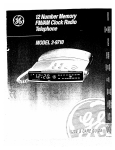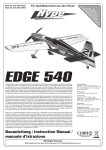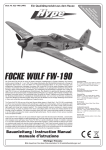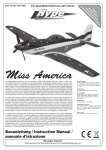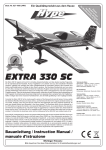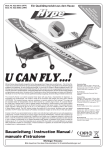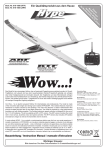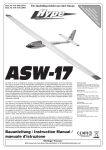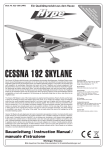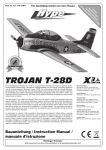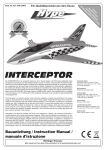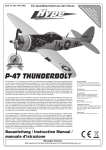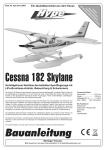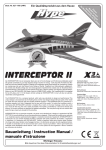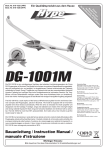Download 1 langer „piep“ Ton
Transcript
Der SWIFT ist ein Mini-Elektro-Hotliner, der für maximalen Flugspaß konstruiert worden ist. Rumpf, Tragfläche und
Leitwerk sind aus dem neuentwickelten Werkstoff HypoDur® gefertigt und verfügen über hohe Festigkeitswerte bei
minimalem Gewicht. Die Tragfläche verfügt zudem über einen Kohlefaserholm zur Verstärkung. Der Antrieb erfolgt
durch ein LiPo-Brushless-Power-System, das perfekt auf den SWIFT abgestimmt ist. Durch den hohen Vorfertigungsgrad ist das Modell mit wenigen Handgriffen flugfertig aufgebaut. Der Antrieb des SWIFT erfolgt über einen
Brushless-Motor, der aus einem 2s 7,4V-LiPo-Akku versorgt wird. Der Miniatur-BLS-Regler ist fertig angeschlossen
und programmiert. Der SWIFT wird als ARF-Version geliefert. Zur Fertigstellung müssen lediglich noch der Empfänger
und der 2s-LiPo-Akku im Modell eingesetzt werden. Die Steuerung des Modells erfolgt über alle drei Achsen. Alle
Ruder sind als spaltfreie Elastoflaps ausgelegt und bieten so höchste aerodynamische Effizienz.
Our SWIFT is a miniature electric hotliner that has been designed for maximum flying fun. The fuselage, wings and
stabilizer are made from the newly developed material HypoDur® and have a high level of rigidity with only minimal
weight. The wing is equipped with a carbon bar for maximum durability. The model is powered by a LiPo brushless
direct drive system that harmonizes perfectly with the SWIFT. The ailerons are linked by one servo that is placed in
the middle of the wing. The linkages for the ailerons are aerodynamical integrated to the wing’s bottom side. Both
servos for elevator and rudder are placed in the fuselage behind the wing. The SWIFT is powered by a brushless
motor with a 2s 7,4 V LiPo battery. The model is available as ARF version. As the final steps you have to install the
receiver and connect the battery. All rudders are attached as gapless elastoflaps for maximum aerodynamic effeciency.
n.
re
t
s ein ne ah
se k ig J
ie t e 4
D ll is ge b 1
e g, r a
od u le
M lze ort
ie p
Sp ells
od
rM
Ein Qualitätsprodukt aus dem Hause
fü
Best.-Nr. 018-1100 (ARF)
Technische Daten
Spannweite: 602 mm; Länge: 490 mm; Gewicht
ca.: 139 g; Motor: Brushless; Akku: LiPo 2s 7,4 V
/ 450 mAh; RC-Anlage: 4 Kanäle
RC-Funktionen
Höhenruder, Seitenruder, Querruder, Motor
Technical Data
Wingspan: 602 mm; Length: 490 mm; Weight
approx.: 139 g; Motor: Brushless; Battery: LiPo 2s
7,4 V / 450 mAh; RC-System: 4 channels
RC-Functions
Elevator, Rudder, Aileron, Motor
Caratteristiche tecniche
apertura alare: 602 mm; lunghezza: 490 mm; peso
circa.: 139 g; motore: Brushless; batteria: LiPo 2s
7,4 V / 450 mAh; radiocomando: 4 canali
funzioni radio
piano di quota, direzionale, alettoni, motore
Hype Swift è un aliante hotliner in miniatura concepito per massimo divertimento in volo. La fusoliera, le ali e il
piano di quota sono realizzati in un nuovo materiale espanso denominato HypoDur, che si distingue per massima
robustezza e nello stesso tempo leggerezza. L‘ala è dotata di un longherone in carbonio per massima resistenza. Il
modello è motorizzato con un sistema brushless diretto che armonizza perfettamente con SWIFT. Gli alettoni sono
comandati con un servocomando collocato nel centro dell‘ala. I tiranti degli alettoni sono integrati aerodinamicamente nella parte inferiore delle ali. Entrambi i servi del piano di quota e del direzionale si trovano nella fusoliera,
dietro all‘ala. SWIFT è motorizzato con un motore brushless che va alimentato con una batteria 2S 7,4 V LiPO. Il
modello è disponibile in versione ARF (praticamente pronto al volo), dovrete solo installare la ricevente e collegare
la batteria. I piani mobili sono realizzati come elastoflaps senza fessure per massima efficienza aerodinamica.
Bauanleitung / Instruction Manual
manuale d'istruzione
Wichtiger Hinweis:
Bitte bewahren Sie diese Dokumentation für Ersatzteilbestellungen auf.
1. Inhaltsverzeichnis / Content / Indice
1. Inhaltsverzeichnis / Content / indice
2. Lieferumfang / Kit Content / contenuto del kit
3. Die Montage des Modells / The Assembly / L'assemblaggio
4. Hinweise zur Bedienung / How To Use / l'utilizzo
5. Sicherheitshinweise / Safety Instructions / per la vostra sicurezza
6. Ersatzteile / Spare Parts / ricambi
7. Garantiebedingungen / Warranty / garanzia
• Entsorgung / Disposal / smaltimento
Bitte entsorgen Sie Elektronik ausschließlich in den dafür vorgesehenen Behältnissen.
Please dispose defective electronic parts in special marked containers.
I rifiuti elettronici vanno smaltiti negli appositi contenitori e seguendo le leggi del rispettivo paese.
Seite 2
Best.-Nr. / Item-No. / art. 018-1100
2. Lieferumfang / Kit Content / Contenuto del kit
2
1
3
4
1 - Kabinenhaube / Canopy / cabina di pilotaggio
2 - Höhenleitwerk / Elevator / piano di quota
3 - Rumpf / Fuselage / fusoliera
4 - Tragfläche / Main Wing / ala
Best.-Nr. / Item-No. / art. 018-1100
Seite 3
3. Die Montage des Modells / The Assembly /
L'assemblaggio
Nehmen Sie das Höhenleitwerk zur Hand. Ziehen Sie die
Schutzfolien von den beiden Klebestreifen auf der Oberund Unterseite ab und setzen Sie das Höhenruder exakt
gerade in den Rumpf, wie dargestellt. Ist alles gerade
ausgerichtet, Klebestreifen gut andrücken. / Take the
elevator and remove the protection film from the adhesive tape. Put the elevator into the fuselage and align it to
the middle. Fix the elevator by pushing the adhesive tape
softly. / Prendere il piano di quota e rimuovere la pellicola
protettiva dai due nastri adesivi. Poi infilarlo perfettamente
centrato nella fusoliera e premere delicatamente i nastri
adesivi per fissare bene la posizione del piano di quota.
Schieben Sie als nächstes die Tragfläche seitlich in den
Rumpf ein. Führen Sie das Kabel des Querruderservos
wie dargestellt. Tragfläche vollständig einschieben und
exakt mittig ausrichten. / Slide the wing into the fuselage from the side. Lead the wire from the aileron servo
asshown. Put the wing into the fuselage completely and
align it exactly to the middle. / Ora infilate l'ala lateralmente nella fusoliera. Posizionate il cavetto del servo degli
alettoni come mostrato in foto. Infilare l'ala totalmente e
centrarla perfettamente.
Nehmen Sie die Kabinenhaube vom Rumpf ab und vergewissern Sie sich, dass das Höhenruderservo auf neutral
steht. Schieben Sie das Höhenrudergestänge in die Aufnahme, richten Sie das Höhenruder auf neutral aus und
sichern Sie das Gestänge mit der Schraube. / Remove the
canopy from the fuselage and put the elevator servo to
neutral position. Insert the elevator linkage into the rudderhorn, set the elevator to neutral and fix the linkage with
the screw. / Togliere la cabina di pilotaggio dalla fusoliera
e accertatevi che il servocomando del piano di quota sia
in posizione neutra. Infilate il tirante del piano di quota
nell'alloggio, portate il piano di quota in posizione neutra e
fissate ora il tirante con la vite.
Seite 4
Best.-Nr. / Item-No. / art. 018-1100
7,4V / 450mAh) in the front area of the fuselage. Do not
connect the battery with the speed controller now! / Ora
inserire la batteria (2s LiPo 7,4V / 450mAh) nella parte
anteriore della fusoliera, ma non collegarla ancora con il
regolatore!
Prüfen Sie nun, ob sich alle Ruder korrekt bewegen. Zuerst den Sender einschalten - danach den geladenen Antriebsakku im Modell anschließen. Betätigen Sie der Reihe
nach alle Funktionen am Sender. Vorsicht im Umganmg
mit der drehenden Luftschraube! Beim Ausschalten zuerst
den Akku im Modell trennen! / Check the function of all
rudders. Switch on the transmitter first! Then connect
the LiPo-Battery to the controller in the model. Move all
rudders one by one. Attention! Be careful with the rotating
propeller! When switching off, disconnect the battery in
the model first! / Verificate ora che tutte le parti mobili si
muovano correttamente: accendere la trasmittente e collegare la batteria caricata al regolatore. Ora provare tutte
le funzioni radio, una per una. Attenzione a non ferirvi con
l'elica in rotazione!
Stellen Sie die maximalen Ruderausschläge gemäß der
nachfolgenden Werte ein. / Adjust the maximum travel of
the control flaps according to the sketch below. / regolare
le escursioni massime dei piani mobili come segue:
QUERruder
AILERON
ALETTONI
Schließen Sie nun die Servos und den Regler am
Empfänger an. Verlegen Sie anschließend die
Empfängerantenne(n). Beachten Sie hierzu die Herstelleranweisungen der RC-Anlage! / Connect the servos and
the speed controller to the receiver. Afterthat install the
antenna(s) in the model. Please note the manual from the
radio manufacturer accordingly. / Ora collegare i servocomandi e il regolatore alla ricevente. Poi posizionare
l'antenna ricevente seguendo le istruzioni del produttore
dell'impianto radio.
35% Expo
27°
27°
SEITenruder
RUDDER
TIMONE
25% Expo
30°
30°
HÖhenruder
ELEVATOR
PIANO DI QUOTA
40% Expo
24°
24°
Abschließend muss der Schwerpunkt am Modell überprüft werden. Dazu werden alle Komponenten (auch der
Akku!) im Modell montiert. Der Schwerpunkt liegt 27 mm
hinter der Nasenleiste. Unterstützen Sie das Modell mit
zwei Fingern exakt im Schwerpunkt und beobachten Sie,
wie das Modell auspendelt. Die Nase des Modells sollte
sich leicht nach unten neigen. Dann ist der Schwerpunkt
optimal justiert. / Before the first flight you have to check
the center of gravity. For doing so you have to mount all
components (also the battery!) in to the model. The CG
is placed 27 mm behind the nose cone of the main wing.
Support the model exactly at the CG on the bottom side of
the wing. Put the model on two fingers and watch the fuselage. The nose should point slightly to the ground. Then
the CG is placed correctly! / Verificare il centro di gravità.
Dovrete usare il modello completo della batteria! Il CG è a
27 mm dietro il bordo d'entrata dell'ala. Tenere il modello
tra due dita come mostrato e guardate la fusoliera. Il muso
dovrebbe puntare leggermento verso il basso.
Schwerpunkt / CG / baricentro
Setzen Sie nun den Antriebsakku (2s LiPo 7,4V / 450mAh)
in den vorderen Teil des Rumpfes ein. Akku jetzt noch
nicht am Regler anschließen! / Install the battery (2s LiPo
27mm
Best.-Nr. / Item-No. / art. 018-1100
Seite 5
Der Brushless-Regler
Der eingebaute Regler im Modell ist flugfertig programmiert. Die nachfolgenden Hinweise sind nur dann erforderlich, falls Sie den Regler
individuell anpassen möchten. Veränderungen am Regler-Setup sollten
nur von erfahrenen Piloten vorgenommen werden.
Technische Daten
Dauerstrom: 6A; Max. Strom kurzz.: 8A; BEC 5V/0,8A; Zellenzahl LiPo:
2-3; Zellenzahl NiCd/NiMH: 5-9; Gewicht: 6g; Abmessungen: 24x12x6mm
3. Programmierung
- Ziehen Sie den Flugakku vom Regler ab
Features
• Extrem kleiner Brushless-Regler
• Besonders niedriger Innenwiderstand
• Hohe Taktfrequenz PWM
• Dynamische Bremse für Klappluftschrauben
• Temperatur-Absicherung
• Überstrom-Absicherung
• Start-Sicherheitssystem mit Anlaufschutz
• Einfache Programmierung durch Programmierkarte
• Sanftanlauf mit wenig Drehmoment für schonende
Behandlung des Getriebes
• Motorabschaltung bei fehlendem Sendersignal oder Funkstörungen
• Hochwertige Anschlusskabel mit Silikon-Isolierung
- Geben Sie mit dem Gashebel „Vollgas“ und schliessen Sie dann den Flugakku an den Regler an
- nach zwei Sekunden hören Sie Tonfolge „123“ und zwei kurze „piep“ Töne warten Sie
weiter fünf Sekunden Tonfolge „56712“ nun befinden Sie sich im Programmiermodus
- mit der folgenden Tabelle können Sie verschiedene Programmierpunkte auswählen, indem Sie
den Gashebel nach der gewünschten Tonfolge in Leerlaufstellung bringen.
Programmierpunkt
Bremse
Akku Type
Abschaltverhalten
Abschaltspannung pro Zelle
Anlaufverhalten
Timing
Werkseinstellung
Exit
Tonfolge
1 kurzer "piep" Ton
2 kurze "piep" Töne
3 kurze "piep" Töne
4 kurze "piep" Töne
1 langer "piep" Ton
1 langer "piep" Ton u. 1 kurzer "piep" Ton
1 langer "piep" Ton u. 2 kurze "piep" Töne
2 lange "piep" Töne
3.1 Bremse / 1 kurzer „piep“ Ton
- nachdem Sie den Programmierpunkt für die Bremse gewählt haben, können Sie nun
wie in der Tabelle ersichtlich die Bremse aktivieren oder deaktivieren. Indem Sie nach der gewünschten Tonfolge
den Gashebel in Vollgasposition bringen.
- wenn Sie den Bremsen Typ gewählt haben, bestätigt der Regler mit der Tonfolge „1515“ und geht zurück zur
Hauptauswahl (Punkt 3)
Bremse aus
Bremse ein
Bremse
Tonfolge
1 langer "piep" Ton
2 lange "piep" Töne
3.2 Akkutype / 2 kurze „piep“ Töne
- hier können Sie Li-ion/Li-poli oder NiMh/NiCd Akkus auswählen. Indem Sie nach der
gewünschten Tonfolge den Gashebel in Vollgasposition bringen.
- wenn Sie den Akkutype Typ gewählt haben, bestätigt der Regler mit der Tonfolge „1515“ und geht zurück zur
Hauptauswahl (Punkt 3)
Li-ion / Li-poly
NiMh/NiCd
Akkutype
Tonfolge
1 langer "piep" Ton
2 lange "piep" Töne
3.3 Abschaltverhalten / 3 kurze „piep“ Töne
- mit dem Abschaltverhalten können Sie entscheiden ob der Motor langsam die Leistung reduzieren soll oder
sofort stehen bleiben soll.
- wenn Sie das Abschaltverhalten ausgewählt haben, geht der Regler wieder zurück zu Punkt 3
Abschaltverhalten
Motor reduziert die Leistung
Motor schaltet sofort ab
Seite 6
Tonfolge
1 langer "piep" Ton
2 lange "piep" Töne
Best.-Nr. / Item-No. / art. 018-1100
3.4 Abschaltspannung pro Zelle(Li-Poly) / 4 kurze „piep“ Töne
- mit der Abschaltspannung kann man den Regler an jede Li-Poly Zelle anpassen von 2,5-3V, die genaue
Abschaltspannung für Ihren Akku entnehmen Sie aus der Anleitung des Akkuherstellers. Sollten sie keine
Informationen zu Ihrem Li-Poly Akku haben, dann sollte die Spannung auf 3V eingestellte werden.
- wenn Sie die Spannung gewählt haben, bestätigt der Regler mit der Tonfolge „1515“ und geht zurück zur
Hauptauswahl (Punkt 3)
Abschaltspannung pro Zelle (Li-Poly Akku)
Tonfolge
2.6V pro Zelle
1 langer "piep" Ton
2.85V pro Zelle
2 lange "piep" Töne
3.1V pro Zelle
3 lange "piep" Töne
3.5 Anlaufverhalten / 1 langer „piep“ Ton
- Das Anlaufverhalten ist in drei Stufen einstellbar, Normal, Soft, Very Soft. Nach Auswahl bestätigt der
Regler mit der Tonfolge „1515“ und geht zurück ins Hauptmenü. (Punkt 3)
Normal
Soft
Very Soft
Startverhalten
Tonfolge
1 langer "piep" Ton
2 lange "piep" Töne
3 lange "piep" Töne
3.6 Timing / 1 langer „piep“ Ton und 1 kurzer „piep“ Ton
- in Punkt 3 haben Sie jetzt den Programmierpunkt für das Timing ausgewählt, nun können Sie
wie in der Tabelle ersichtlich für jeden Motor-Typ das passende Timing einstellen.
- wenn Sie Timing gewählt haben, bestätigt der Regler mit der Tonfolge „1515“ und geht zurück zur
Hauptauswahl (Punkt 3)
Low 0°
Middle 15°
High 30°
Timing
Tonfolge
1 langer "piep" Ton
2 lange "piep" Töne
3 lange "piep" Töne
3.7 Exit / 2 lange „piep“ Töne
- bringen Sie nach den zwei langen „piep“ Tönen, den Gashebel in Leerlaufstellung. Der Regler bestätigt
mit einem „piep“ Ton und wird scharf geschaltet.
3.8 Betriebsstörung
Beanstandung
Nach Anschluss des Akkus, keine Funktion des
Motors und kein Sound
Nach Anschluss des Akkus, keine Funktion des
Motors u. "piep-piep"-"piep-piep" -"piep-piep"
("piep-piep" Ton Länge 1 Sekunde)
Nach Anschluss des Akkus, keine Funktion des
Motors u. "piep"-"piep" -"piep" ("piep" Ton Länge
2 Sekunde)
Nach Anschluss des Akkus, keine Funktion des
Motors u. "piep-piep -piep" ("piep" Ton Länge
0,25 Sekunde)
Nach Anschluss des Akkus, keine Funktion des
Motors spezieller Ton "56712" nach zwei piep
Tönen "piep-piep"
möglich Ursachen
Abhilfe
Stecker zwischen Akku und Regler nicht in
Ordnung
Überprüfen Sie die Kabel und den Stecker
zwischen Akku und Regler
Eingangsspannung nicht OK
Überprüfen Sie die Spannung des Akkus
Kein Signal vom Sender od. Empfänger
Überprüfen Sie Sender und Empfänger bzw.
Anschlusskabel zum Regler
Gashebel nicht in Drosselstellung
bringen sie den Gashebel in Drosselstellung
Gashebel in Vollgasstellung Regler geht in den
Programmiermodus
Ändern Sie den Servoweg (Servoreverse)
Seite 5
Best.-Nr. / Item-No. / art. 018-1100
Seite 7
Brushless-Speedcontroller
Features
The integrated speedcontroller is fully programmed and ready to
• Very low internal resistance!
fly. The following procedures are necessary only, if you want to
• High clock rate PWM
make changes to the setup of the speedcontroller. Setup chan-
• Dynamic brakes
ges are recommended for experienced pilots only!
• Temperature safeguard
• Extremely compact size
• Over-current safeguard
Technical Data
• Start safety system with starting contactor
Cont. Current: 6A; Max. Current: 8A; BEC 5V/0,8A; Number of
• Programming with the programming card
Cells LiPo: 2-3; Number of Cells NiCd/NiMH: 5-9; Weight: 6g;
• Engine shut-down if there is no transmitter signal
Size: 24x12x6mm
• High quality silicone connection cables
Programmable Items
1. Brake Setting: Enabled / Disabled, default is Disabled
2. Battery Type: Li-xx(Li-ion or Li-poly) / Ni-xx(NiMH or NiCd): default is Li-xx.
3. Low Voltage Protection Mode(Cut-Off Mode): Soft Cut-Off (Gradually reduce the output power) or
Cut-Off (Immediately stop the output power). Default is Soft Cut-Off.
4.Low Voltage Protection Threshold(Cut-Off Threshold): Low / Medium / High, default is Medium.
• For lithium batteries, the number of battery cells is calculated automatically. Low / medium / high cutoff voltage for each
cell is: 2.6V/2.85V/3.1V. For example: For a 3 cells lithium pack, when “Medium” cutoff threshold is set, the cut-off voltage
will be: 2.85*3=8.55V.
• For nickel batteries, low / medium / high cutoff voltages are 0%/45%/60% of the startup voltage (i.e. the initial voltage of
battery pack), and 0% means the low voltage cut-off function is disabled. For example: For a 10 cells NiMH battery, fully
charged voltage is 1.44*10=14.4V, when “Medium” cut-off threshold is set, the cut-off voltage will be:14.4*45%=6.5V
5.Startup Mode: Normal /Soft /Super-Soft, default is Normal.
Normal is preferred for fixed-wing aircraft. Soft or Super-soft are preferred for helicopters. The initial acceleration of the Soft and
Super-Soft modes are slower in comparison, usually taking 1 second for Soft startup or 2 seconds for Super-Soft startup from initial
throttle advance to full throttle. If the throttle is closed (throttle stick moved to bottom) and opened again (throttle stick moved to top)
within 3 seconds of the initial startup, the restart-up will be temporarily changed to normal mode to get rid of the chances of a crash
caused by slow throttle response. This special design is very suitable for aerobatic flight when quick throttle response is needed.
6.Timing: Low / Medium / High, default is Low.
Usually, low timing value can be used for most motors. We recommend the Low timing value for 2 poles motor and Medium timing
value for motors with more than 6 poles to get a high efficiency. For higher speed, High timing value can be chosen. After changing
the timing setting, please test your RC model on ground prior to flight!
Seite 8
Best.-Nr. / Item-No. / art. 018-1100
Manual of Sensorless Brushless Motor Speed Controller
Ver HW-01-081027.1
Normal startup procedure:
Move throttle
Connect battery
stick to
pack to ESC,
bottom and
special tone like
then switch
on transmitter.
Several “beep-” tones
When self-test is
Move throttle stick
should be emitted,
finished, a long
upwards to go flying
“ 123” means
presenting the number
“beep-----”tone
power supply is OK
of lithium battery cells
should be emitted
Throttle range setting: (Throttle range should be reset whenever a new transmitter is being used)
Switch on
Connect battery
transmitter,
pack to ESC,
move throttle
and wait for
stick to top
about 2 seconds
“Beep-Beep-” tone
Move throttle stick to the
A long “Beep-” tone should
bottom, several “beep-” tones
be emitted, means throttle
highest point has been
should be emitted, presenting
range lowest point has
correctly confirmed
the number of battery cells
been correctly confirmed
should be emitted,
means throttle range
Program the ESC with your transmitter (4 Steps):
2. Select programmable items:
1.
Enter program mode
2.
Select programmable items
3.
Set item’s value (Programmable value)
4.
Exit program mode
After entering program mode, you will hear 8 tones in a loop with
the following sequence. If you move the throttle stick to bottom
within 3 seconds after one kind of tones, this item will be selected.
1. Enter program mode
1)
Switch on transmitter, move throttle stick to
top , connect the battery pack to ESC
2)
Wait for 2 seconds, the motor should emit
special tone like “beep-beep-”
3)
Wait for another 5 seconds, special tone like
“
” should be emitted, which means
program mode is entered
1.
“beep”
brake
(1 short tone)
2.
“beep-beep-”
battery type
(2 short tone)
3.
“beep-beep-beep-”
cutoff mode
(3 short tone)
4.
“beep-beep-beep-beep-” cutoff threshold
(4 short tone)
5.
“beep-----”
startup mode
(1 long tone)
6.
“beep-----beep-”
timing
7.
“beep-----beep-beep-”
8.
“beep-----beep-----”
(1 long 1 short)
set all to default (1 long 2 short)
e xi t
(2 long tone)
Note: 1 long “beep-----” = 5 short “beep-”
3. Set item value (Programmable value):
4. Exit program mode
You will hear several tones in loop. Set the value matching to a tone by moving throttle stick
There are 2 ways to exit
to top when you hear the tone, then a special tone “
program mode:
” emits, means the value is set
and saved. (Keeping the throttle stick at top, you will go back to step 2 and you can select
1.
other items; Moving the stick to bottom within 2 seconds will exit program mode directly)
Tones
“beep-”
“beep-beep-”
“beep-beep-beep”
Items
1 short tone
2 short tones
3 short tones
Brake
Off
On
Battery type
Li-ion / Li-poly
NiMH / NiCd
Cutoff mode
Soft-Cut
Cut-Off
Low
Medium
High
Normal
Soft
Super soft
Low
Medium
High
Cutoff threshold
Start mode
Timing
In step 3, after special
tone “
”, please
move throttle stick to
the
bottom
position
within 2 seconds.
2.
In step 2, after tone
“beep-----beep-----”(ie.
The item #8), move
throttle stick to bottom
within 3 seconds.
-4-
Best.-Nr. / Item-No. / art. 018-1100
Seite 9
Il regolatore brushless
Caratteristiche
Il regolatore in dotazione è già programmato in fabbrica. Le
• resistenza interna molto bassa
seguenti procedure sono necessarie solo se volete apporta-
• Grande velocità di commutazione
re delle modifiche. Consigliamo solo a piloti esperti di fare
• Freno dinamico
modifiche.
• protezione contro il surriscaldamento
• dimensioni compatte
• Protezione contro sovracorrente
• Sistema di avviamento di sicurezza con contattore di partenza
Caratteristiche tecniche:
• Programmazione con apposita programming card
Corrente continua: 6A; Corrente massima: 8A; BEC
• Spegnimento automatico del motore in assenza di segnale-radio
5V/0,8A; numero di celle LiPo: 2-3; numero di celle NiCd/
• Cavì di connessione di alta qualità in silicone
NiMH: 5-9; peso: 6g; Size: 24x12x6mm
Caratteristiche programmabili
1. Freno: attivo / disattivo (programmazione default: disattivo)
2. Tipo di batteria: Li-xx(Li-ion oppure Li-poly) / Ni-xx(NiMH oppure NiCd): (default è Li-xx.)
3. 3. Protezione per bassa tensione ("Cut-off mode"): E' possibile scegliere fra "Soft Cut-Off " (che riduce progressivamente la potenza del motore) e "Cut-off" (che ferma immediatamente il motore quando la tensione minima raggiunge la soglia critica). Il settaggio
di default è "Soft Cut-Off"
4. Soglia di protezione per bassa tensione: selezionabile fra "low", "medium" e "high". Il valore di default è "medium".
• Per le batterie al litio, il numero di celle viene riconosciuto automaticamente. Il voltaggio cut-off basso / medio / alto per ogni
cella è : 2.6V/2.85V/3.1V. Per esempio: Per un pacco Lipo a tre celle, con l'impostazione "soglia di protezione Medium”, la soglia di
protezione per bassa tensione sarà: 2.85*3=8.55V.
• per le batterie al NiMh, il voltaggio cutoff basso / medio / alto è al 0%/45%/60% del voltaggio iniziale del pacco batteria, e
0% significa che la funzione low voltage cut-off è disabilitata. Esempio: Il voltaggio di un pacco NiMH a 10 celle totalmente caricato è
1.44*10=14.4V, con la soglia del cutoff impostata su “medio”, il cutoff voltage sarà a:14.4*45%=6.5V
5. "Startup mode" (avviamento del motore): "Normal", "Soft", "Super-soft". Il valore di default è "normal".
L'impostazione "Normal" è per aeromodelli. "Soft" oppure "Super-soft" è adatto per elicotteri. L'accelerazione iniziale del modo Soft e
SuperSoft è più lenta: normalmente il motore impiega un secondo per Soft Startup o 2 secondi per
Super- Softstartup.
Se il gas-motore viene tolto (stick in basso) e ridato completamente (stick in alto) entro tre secondi dal primo avviamento, la ripartenza avviene sempre in modo "normale" per evitare il rischio di crash in conseguenza ad una risposta troppo lenta del motore. Questa
particolarità è molto utile nel volo acrobatico dove occorre una veloce risposta del comando del gas.
6.Timing (anticipo): basso / medio / alto, default è basso.
Normalmente, un timing basso può essere usato per la maggior parte dei motori. Consigliamo l'anticipo basso per motori a 2 poli e
timing medio per motori con più di 6 poli per ottenere alta efficienza. Per maggiore velocità, potete selezionare timing alto. Una volta
che cambiate il timing, provate il modello prima a terra!
Seite 10
Best.-Nr. / Item-No. / art. 018-1100
Manual of Sensorless Brushless Motor Speed Controller
Ver HW-01-081027.1
Procedura
Startup
normale:
Normal startup
procedure:
portare
lo stick
Move
throttle
radio in basso,
stick tola
poi accendere
trasmittente
bottom and
Collegare
la batteria
al
Connect
battery
regolatore, un segnale
pack
to ESC,
acustico
"x123"
significa che
l'alimentazione
è ok!! like
special tone
Ora sentite diversi beep che
Several “beep-”
rappresentano
il numerotones
di celle
della batteria Lipo.
Quando l'autotest è
Whensentirete
self-test
terminato,
un is
lung
beep-----.
should be emitted,
Portare lo stick della radio in su.
Moveandare
throttle
stick
Ora potrete
a volare.
upwards to go flying
finished, a long
then switch
“ 123” means
presenting the number
“beep-----”tone
on transmitter.
power supply is OK
of lithium battery cells
should be emitted
Impostazione motore ("throttle range setting", da fare ogni volta che si usa una nuova trasmittente):
Throttle range setting: (Throttle range should be reset whenever a new transmitter is being used)
accendere la trasmittente,Switch
portare on
lo stick
trasmittente in su
transmitter,
collegare la batteria al
Connect
battery
regolatore
e attendere
due secondi
pack to ESC,
sentite
beep beep, ciòtone
significa
“Beep-Beep-”
che il punto massimo del motore
should
be emitted,
è stato
confermato
muovere lo stick motore in basso, sentite
Move
throttle
stickcollegate
to the
tanti beep
quante
celle sono
Un beep lungo conferma che il punto
A long “Beep-” tone should
motore al minimo è stato confermato
bottom, several “beep-” tones
be emitted, means throttle
means throttle range
move throttle
and wait for
highest point has been
should be emitted, presenting
range lowest point has
stick to top
about 2 seconds
correctly confirmed
the number of battery cells
been correctly confirmed
programmare il regolatore con la trasmittente 4 passi: :
Program the ESC with your transmitter (4 Steps):
1.1.entrare
program
mode
Enternel
program
mode
2. selezionare funzione da programmare
3.2.impostare
valore
Select programmable
items
4. uscire
3.
Set item’s value (Programmable value)
4.
Exit program mode
within 3 seconds after one kind of tones, this item will be selected.
1.1.entrare
program
mode
Enter nel
program
mode
a) accendere la TX, muovere lo stick in alto, collegare
la1)batteria
al regolatore
Switch
on transmitter, move throttle stick to
b) attendere 2 secondi, finché senti beep beep
top , connect
the battery
pack
to ESC
c) attendere
altri 5 secondi,
finché
senti
un tono
speciale come
56712, ora sei entrato nel program
2) Wait for 2 seconds, the motor should emit
mode
special tone like “beep-beep-”
3)
Wait for another 5 seconds, special tone like
“
2. Selezionare funzioni programmabili:
2. Select programmable items:
una volta entrato nel program mode, senti 8 sequenze di beep nella
seguente
sequenza.
Se sposti
stick
minimo
After entering
program
mode,loyou
willmotore
hear 8altones
in entro
a loop3 with
secondi dopo la rispettiva sequena, hai selezionato la rispettiva
funzione:
the following sequence. If you move the throttle stick to bottom
” should be emitted, which means
program mode is entered
1.
“beep”
freno
brake
(1 short tone)
2.
“beep-beep-”
tipo
batteria
battery
type
(2 short tone)
3.
“beep-beep-beep-”
cutoff mode
(3 short tone)
4.
soglia cutoff
“beep-beep-beep-beep-” cutoff
threshold
(4 short tone)
5.
“beep-----”
startup mode
(1 long tone)
6.
“beep-----beep-”
timing
7.
“beep-----beep-beep-”
8.
“beep-----beep-----”
and saved. (Keeping the throttle stick at top, you will go back to step 2 and you can select
other items; Moving the stick to bottom within 2 seconds will exit program mode directly)
“beep-”
“beep-beep-”
“beep-beep-beep”
Items
1 short tone
2 short tones
3 short tones
Brake
Off
On
Battery type
Li-ion / Li-poly
NiMH / NiCd
Cutoff mode
Soft-Cut
Cut-Off
Low
Medium
High
Normal
Soft
Super soft
Low
Medium
High
Cutoff threshold
Start mode
Timing
reimpostare
tutto (1 long 2 short)
set
all to default
come default
e xi t
(2 long tone)
Nota:
= 5=beep
corti
Note:11lungo
long beep-----“beep-----”
5 short
“beep-”
3. Programmare i valori
3. Set item
(Programmable
value):il valore che corrisponde ad un certo suono porSentirete
unavalue
sequenza
di suoni. Regolare
tando lo stick trasmittente in alto, quando senti il suono; poi sentirai un suono speciale
You
will ciò
hear
several tones
in loop.èSet
theimpostato
value matching
to aMantenendo
tone by moving
throttle
stick
1515,
conferma
che il valore
stato
e salvato.
lo stick
motore
intoaltro,
puoi tornare
passo
n. then
2 e puoi
selezionare
Portando
stickismotore
top when
you hearalthe
tone,
a special
tone “ altre funzioni.
” emits, means
thelovalue
set
in giù entro 2 secondi uscirà direttamente dal program mode.
Tones
(1 long 1 short)
4.Uscire
dal program
mode
4. Exit program
mode
Ci sono due modi per
There are 2 ways to exit
uscire.
1. al passo 3, dopo il suono
program mode:
speciale
1515, muovere lo
stick motore in giù entro 2
1. In step 3, after special
secondi.
2. al passo
tone “2, dopo”,beep
please
-------beep-------- (esempio
funzione
n. 8),
muovere
move
throttle
sticklo to
stick giù entro 3 secondi.
the
bottom
position
within 2 seconds.
2.
In step 2, after tone
“beep-----beep-----”(ie.
The item #8), move
throttle stick to bottom
within 3 seconds.
-4-
Best.-Nr. / Item-No. / art. 018-1100
Seite 11
4. Hinweise zur Bedienung / How To Use / istruzioni d'uso
4.1 Laufrichtung der Ruder / Sterring Direction Of Flight Controls / direzione dei piani mobili
Vor dem Erstflug des Modells muß unbedingt die Laufrichtung aller Ruder überprüft werden. / Before the first flight of the model, the
steering direction must be checked carefully! / prima del primo volo dovrete controllare il senso di escursione dei piani mobili
Höhenruder / Elevator / piano di quota
Wird der Höhenruderknüppel am Sender nach hinten gezogen, muß das Höhenruder nach oben ausschlagen. Wird der Höhenruderknüppel nach vorn gedrückt, muß das Höhenruder nach unten ausschlagen. / When you pull the elevator stick, the elevator has to
move up, the model will climb. When you push the elevator stick, the elevator has to move down, the model will decline. / Tirando lo
stick del piano di quota, il piano mobile deve andare in sù, spingendolo in avanti, il piano deve andare giù.
Seitenruder / Rudder / direzionale
Das Modell wird von hinten betrachtet. Wird der Seitenruderknüppel am Sender nach links bewegt, muß das Seitenruder nach links
ausschlagen. Entsprechend umgekehrt erfolgt der Ausschlag für die andere Richtung. / Take a look to the model from behind. When
you move the rudder stick to the left, the rudder has to move to the left. For the right side it works accordingly. /Guardare il modello da
dietro: muovendo lo stick del direzionale a sinistra, il piano mobile si muove a sinistra e vice versa.
Querruder / Aileron / alettoni
Das Modell wird von hinten betrachtet. Wird der Querruderknüppel am Sender nach links bewegt, muß die linke Querruderklappe nach
oben und die rechte Querruderklappe nach unten ausschlagen. Entsprechend umgekehrt erfolgen die Ausschläge für die andere Richtung. / Take a look to the model from behind. When you move the aileron stick to the left, the left flap has to move up and the right flap
has to move down. For the right side it works accordingly. / Guardando il modello da dietro e muovendo lo stick degli alettoni a sinistra,
l'alettone sinistra deve andare sù e quello destro in giù. E vice versa.
Motor / Motor / motore
Wird der Gasknüppel in die Leerlauf Position gebracht, muß der Motor stillstehen. Bei Vollgas muss der Motor seine maximale Drehzahl erreichen. / When you move the throttle stick to idle, the motor has to stop completely. Putting the throttle stick to full power, the
motor has to reach its maximum rpm. / Portando lo stick motore in posizione minimo, il motore si deve fermare, in posizione massima
invece deve andare ai massimi giri.
4.2 Startvorgang / Take Off / partenza
• Starten Sie prinzipiell immer gegen den Wind! / Alwas start the model against the wind! / Partite sempre contro il vento.
• Überprüfen Sie die Funktion aller Ruder vor jedem(!) Start. / Check all rudder controls before each(!) start. / Controllate tutti i piani
mobili prima della partenza.
• Geben Sie Vollgas und korrigieren Sie in Bodennähe nur mit kleinen Steuerausschlägen. / For take off always use maximum power.
When you are near the ground only small control action is recommended. / Per la partenza accelerare al massimo.
• Steigen Sie in einem flachen Winkel. / Climb in a smooth angle. / Salire in un angolo piatto.
4.3 Landevorgang / Landing Procedure / Atterraggio
• Drosseln Sie den Motor und fliegen Sie in 30 m Entfernung mit Rückenwind parallel zur Landebahn. / Reduce motor power and fly
parallel to the runway in a distance of 30 meters. / Diminuire i giri motore e volare a 30 m di distanza parallelamente alla pista di atterraggio.
• Fliegen Sie eine 90° Kurve in Richtung Landebahn und bauen Sie Höhe ab. / Turn 90° to the runway and decline continously. / Effettuate ora una virata a 90° in direzione della pista di atterraggio e diminuite la quota.
• Fliegen Sie erneut eine 90° Kurve, Sie fliegen nun direkt auf die Landebahn zu. Turn again 90° to the runway and decline continously.
You are now approaching the runway. / Effettuate un'ulteriore virata a 90° in direzione della pista e continuate a scendere.
• Lassen Sie das Modell weiter sinken bis das Modell 1 m über der Landebahn schwebt. / Decline until you are about 1 meter over the
runway. / Continuate la discesa fino a librarvi 1 m sulla pista.
• Ziehen Sie den Höhenruderknüppel etwas stärker und halten Sie ihn gezogen. / Pull the elevator carefully and keep it pulled. / Tirate
lo stick del piano di quota un po' di più e tenetelo tirato.
• Je mehr sich das Modell dem Boden nähert, desto mehr muß der Höhenruderknüppel gezogen werden. Da das Modell ständig langsamer wird, setzt es sich praktisch von allein auf die Landebahn. / The closer you come to the ground the more you have to pull the
elevator. As the model gets slower, it will land more or less automatically. / Più vi avvicinate al suolo, più dovrete tirare il piano di quota.
Il modello rallenta continuamente atterrando praticamente da solo sulla pista.
Seite 12
Best.-Nr. / Item-No. / art. 018-1100
5. Sicherheitshinweise / Safety Instructions / avvertenze
Allgemeine Sicherheitshinweise für Modelle mit Elektroantrieb
Dieses Modell ist kein Spielzeug, geeignet für Modellsportler ab 14 Jahren.
Verwenden Sie das fertige Modell ausschließlich gemäß seiner vorgesehenen Bestimmung, wie unter dem Kapitel
„Hinweise zur Bedienung“ in der Bauanleitung / Bedienungsanleitung erläutert.
Montieren Sie das Modell grundsätzlich nur nach der Bauanleitung / Bedienungsanleitung zusammen. Nehmen Sie
Umbauten nur vor, unter Verwendung von empfohlenen original Ersatz- und Tuningteilen aus dem Hause
KYOSHO Deutschland.
Beachten Sie hierzu die Gebrauchsanweisung anderweitig zur Anwendung kommender
Komponenten (z.B. Fernsteuerungsanleitung).
Die Inbetriebnahme ist nicht eher gestattet, bis das Modell laut beiliegender Bauanleitung komplett montiert ist.
Überprüfen Sie vor der Inbetriebnahme des Modelles die Funktionssicherheit laut Checkliste und benutzen Sie
einen Frequenzkanal, der nicht bereits von anderen Modellsportlern belegt ist oder diese stört.
Betreiben Sie das Modell nur dort, wo sich keinerlei Personen oder Tiere aufhalten und eine Beschädigung
anderer Güter auszuschließen ist. Handeln Sie eigenverantwortlich und überprüfen Sie das gewählte Gelände
vor Inbetriebnahme des Modells auf seine Eignung.
Stoppen Sie das Modell unverzüglich bei einer Störung und beseitigen Sie sofort die Ursache, falls Sie keine
Kontrolle mehr über das Modell haben.
Berühren Sie keine rotierenden und/oder heißen Motorteile während des Betriebes oder der Abkühlphase.
Warten Sie Ihr Modell nach jedem Einsatz und ersetzen Sie Verschleißteile, um einen sicheren Betrieb zu gewährleisten.
Fassen Sie das Modell während und nach dem Betrieb stets so an, daß Sie keinesfalls mit Teilen des Antriebs
in Berührung kommen.
Bedenken Sie, daß Kunststoffteile bei niedrigen Außentemperaturen in Ihrer Schlagzähigkeit nachlassen können,
daß heißt, die Belastungsfähigkeit sinkt.
Sofern Sie nicht über ausreichende Kentnisse im Umgang mit Funktionsmodellen verfügen, wenden Sie sich an
einen erfahrenen Modellsportler oder Modellbauclub.
Schützen Sie sich bei Testläufen vor, eventuell durch rotierende Teile, aufgewirbeltem Schmutz bzw. Steinchen.
Schützen Sie alle elektrischen Komponenten vor Wasser und Fremdkörpern.
Sorgen Sie dafür, daß der Motor nicht überlastet oder blockiert wird.
Lassen Sie den Motor nach dem Betrieb ausreichend abkühlen.
Laden und entladen Sie Ihre Akkus sorgfältig und achten Sie darauf, daß die Akkus und Anschlußkabel keinerlei
Beschädigungen aufweisen.
Schließen Sie den Akku niemals "kurz" durch Zusammenführen des Plus- und Minuspols.
Verlegen Sie die Kabel im und am Modell so, daß diese nicht in oder an rotierende oder heiße Teile geraten.
Stellen Sie sicher, daß der Fahrtenregler ungehindert funktionieren kann.
CE-Zertifizierung für Elektromotor; Angewandte Normen: EN 50081-1, IEC 1000-4-2, IEC 1000-4-3, EN 50082-1
Bei technischen Rückfragen, wenden Sie sich bitte an unsere Service-Hotline: 04191-932678 (Mo.-Do.: 14.00-17.30 Uhr).
Best.-Nr. / Item-No. / art. 018-1100
Seite 13
5. Sicherheitshinweise / Safety Instructions / avvertenze
General Safety Instructions For Electric Models
This model is not a toy. Allowed for children over 14 years.
Use the model accordingly to chapter 5 "How To Use" in this instruction manual.
Assemble the model accordingly to this instruction manual. Do not alter or modify the model. Only use parts that are officially
recommended by KYOSHO Deutschland.
Always pay close attention to the manuals that are included to accessory parts.
Do not fly the model before you have finished the assembly completely according to this manual.
Before you fly, check all functions of the model carefully. Check if your frequency is clear and not used by any
other pilots in your area. This may cause radio interference.
Never fly your model near other human beings, animals or other obstacles. You are responsible for flying the model, so
you have to check carefully your flight area.
Stop flying immediately if you realize any radio interference. Check the system for the cuase and change the frequency
if necessary.
Do not touch any moving or hot motor parts during action! Let all components cool down before you handle them.
Check your model carefully after each flight. Replace parts if they are worn out or if they are defective.
Keep your hands out of reach from rotating or hot parts of the model.
Keep in mind that plastic parts easily break under cold temperature conditions.
If you are a novice in flying you should ask experienced pilots for assistance during your first flights.
Protect yourself from dust and other small things when you test run your propeller drive on the ground.
Keep all electronic components dry and clean!
Take care that your motor does not get overload or gets blocked under full power.
Let the motor cool down after restarting the model again.
Charge your batteries carefully. Always watch the charging process and make sure all connectors are in good conditions.
Do not shorten the battery by connecting the pluspole with the minuspole directly!
Make sure that the wires do not touch rotating or hot parts of the model.
CE-certification for electric motor: EN 50081-1, IEC 1000-4-2, IEC 1000-4-3, EN 50082-1
In case of technical questions please contact our helpdesk by phone: +49-4191-932678 or by e-mail: [email protected]
Seite 14
Best.-Nr. / Item-No. / art. 018-1100
questo modello non è un giocattolo, è adatto a persone di età non inferiore ai 14 anni
non usare i modelli per scopi diversi da quelli previsti nelle istruzioni
montare il modello seguendo le istruzioni, per modificarlo usare esclusivamente modifiche (tuning parts)
originali della casa Kyosho Deutschland GmbH, usare solo ricambi originali.
per quanto concerne accessori di altri produttori (radiocomando etc.) seguire le istruzioni del rispettivo produttore
non è permesso di usare il modello finchè il montaggio non è completato secondo le istruzioni
prima di mettere in moto il modello, effettuare i controlli suggeriti nelle istruzioni e accertarvi che la vostra frequenza radio non
sia già in uso da parte di un’altro modellista presente sul campo
usare il modello solo in luoghi sicuri, dove non si trovano nè persone nè animali nè oggetti che potreste
mettere in pericolo. Siete pienamente responsabili per eventuali danni recati dal vostro modello.
se si dovesse verificare un’interferenza, fermare subito il modello e risolvere il problema
state attenti a non toccare parti calde (motore, silenziatore, batteria motore) o parti rotanti del modello,
controllate tutte le parti del modello dopo ogni uso e sostituite parti che mostrano segni di logoramento.
assicuratevi di non venire a contatto - durante e dopo l'uso - con parti della propulsione e trasmissione
a temperature basse, le parti in plastica perdono di resistenza e diventano più fragili
se siete un neofita, chiedere aiuto ad un modellista esperto.
proteggetevi da polvere, pietre etc. alzate dalle parte in rotazione
proteggete l'elettronica contro le infiltrazioni di acqua e corpi estranei
provvedete a non sovvraccaricare il motore e a non bloccarlo
fare raffreddare il motore dopo l'uso
caricate con cura le batteria e controllate periodicamente che i cavi di collegamento siano integri
non mettere in corto circuito la batteria mettendo a contatto il polo negativo con quello positivo.
i cavi elettrici nel modello NON devono venire a contatto con parti in rotazione o con parti calde
assicuratevi che il regolatore di giri possa funzionare senza problemi e impedimenti
certificazione CE del motore elettrico; norme applicate: EN 50081-1, IEC 1000-4-2, IEC 1000-4-3, EN 50082-1
Per info tecniche potete rivolgervi a [email protected].
Best.-Nr. / Item-No. / art. 018-1100
Seite 15
SICHERHEITSINFORMATIONEN ZU DEN IM MODELL ENTHALTENEN
LITHIUM- POLYMER AKKUS UND LADEGERÄTEN
1. Allgemein
• Lithium-Polymer (kurz: LiPo) Akkus bedürfen besonderer Aufmerksamkeit
• Fehlbehandlung bei Ladung und Entladung können zu Feuer, Rauchentwicklung, Explosionen und Vergiftung führen.
• Die Nichtbeachtung von Anleitungs- und Warnhinweisen kann zu Leistungseinbußen oder sonstigen Defekten führen.
• Die unsachgemäße Lagerung bei zu hohen oder zu niedrigen Temperaturen kann die Kapazität verringern.
2. Ladung
• LiPo-Akkus stets nur auf einer nicht brennbaren, hitzebeständigen und nicht leitenden Unterlage laden.
• Leicht entzündliche Gegenstände von der Ladeanordnung fernhalten.
• Ladevorgang stets nur unter Aufsicht.
• Nur das beiliegende oder ein von uns ausdrücklich zur Ladung des Akkus dieses Modells freigegebenes Ladegerät verwenden.
• Spannungen von über 4,20 V pro Zelle führen zu dauerhafter Beschädigung der Zelle und können Feuer, Rauchentwicklung und Explosion zur Folge haben.
• Akku nicht verpolen! Andernfalls laufen anormale chemische Reaktionen ab, die den Akku zerstören und sogar zu Feuer, Rauchentwicklung oder Explosion führen können.
3. Entladung
• Der Entladestrom darf 8C (= 8-fache Nennkapazität) nicht überschreiten.
• Nicht unter 2,5 V pro Zelle entladen, andernfalls wird Zelle dauerhaft geschädigt.
• Betrieb sofort einstellen, wenn Leistung des Modells stark abfällt.
• Kurzschlüsse und hohe Temperaturen (max. 70°C) vermeiden, da sonst Gefahr der Selbstentzündung des Akkus; Temperatur ggf. mit
unserem HYPE Infrarot Thermometer überprüfen.
4. Beschädigung des Gehäuses und der Folie
• Gehäusefolie vor Beschädigung durch scharfe Gegenstände schützen.
• Beschädigungen der Folie machen den Akku unbrauchbar
• Akku verformsicher in das Modell einbauen, auch im Falle eines Absturzes oder Crashs
• Temperaturen über 70°C können das Gehäuse beschädigen, so dass Elektrolyt austreten kann. In diesem Fall wäre der Akku unbrauchbar und zu entsorgen.
5. Beschädigte Zellen
• Keine Weiterverwendung von beschädigten Zellen !
• Kennzeichen beschädigter Zellen: Verformung, beschädigte Folie, Geruch oder Auslauf von Elektrolyten
• Gesetzliche Entsorgungsvorschriften (Akku = Sondermüll) beachten
6. Warnhinweise
• Nicht ins Feuer werfen !
• Nicht in Flüssigkeiten jeglicher Art eintauchen; jeglichen Kontakt mit Flüssigkeiten vermeiden.
• Außerhalb der Reichweite von Kindern lagern.
• Akku nicht demontieren, Gefahr von Feuer, Rauch und Explosion sowie Verätzungen.
• Jeglichen Kontakt mit Elektrolyt vermeiden. Sofern doch Kontakt aufgetreten sein sollte, sofort mit viel frischem Wasser abspülen und
den Arzt konsultieren.
• Bei Nichtbenutzung des Modells den Akku immer entnehmen und vor Inbetriebnahme rechtzeitig aufladen.
• Lagerung nur auf einer hitzebeständigen, nicht brennbaren und nicht leitenden Unterlage.
• Tiefentladene Akkus nicht weiter verwenden.
7. Garantieausschluß
• Da durch uns die richtige Ladung und Entladung des Akkus nicht überwacht werden kann, wird jegliche Garantie vorsorglich ausgeschlossen.
8. Haftungsausschluß
• Da wir weder die Einhaltung der Montage- und Betriebsanleitung in Zusammenhang mit dem Modell, noch die Bedienung und Methoden bei Installation, Betrieb, Verwendung und Wartung des Modells nebst zugehöriger Elektronik überwachen können, übernehmen wir
keinerlei Haftung für Verluste, Schäden oder Kosten, die sich aus der fehlerhaften Verwendung und dem Betrieb ergeben oder in irgendeiner Weise damit zusammenhängen.
• Ausdrücklich lehnen wir auch jegliche Folgeschäden, die sich im Zusammenhang mit Installation, Betrieb, Verwendung und Wartung
des Modells ergeben, ab.
• Soweit vom Gesetzgeber nicht anders vorgeschrieben, ist unsere Verpflichtung zur Leistung von Schadenersatz – gleich aus welchem
Rechtsgrund – auf den Rechnungswert der an dem schadenstiftenden Ereignis unmittelbar beteiligten Warenmenge begrenzt. Dies gilt
nicht, sofern wir nach zwingenden gesetzlichen Vorschriften wegen Vorsatz oder grober Fahrlässigkeit unbeschränkt haften.
HYPE im Vertrieb der KYOSHO DEUTSCHLAND GMBH
Nikolaus-Otto-Straße 4
24568 Kaltenkirchen
Germany
Seite 16
Best.-Nr. / Item-No. / art. 018-1100
IMPORTANT SAFETY INSTRUCTIONS AND WARNINGS FOR
LITHIUM-POLYMER-BATTERIES
1. General Guidelines and Warnings
• LiPo batteries are NOT charged as you receive them. They contain approximately 50% of a full charge as recommended for
shipment and long term storage .
• Use Lithium Polymer specific chargers only. Do not use a NiCd or NiMh charger - Failure to do so may cause a fire, which may
result in personal injury and property damage.
• Never charge batteries unattended. When charging LiPo batteries you should always remain in constant observation to monitor
the charging process and react to potential problems that may occur.
• Some LiPo chargers on the market may have technical deficiencies that may cause them to charge LiPo batteries incorrectly. It is
solely the responsibility of the user to assure that the charger used works properly.
• If at any time you witness a battery starting to balloon or swell up, discontinue the charging process immediately. Disconnect the
battery and place it in a safe observation area for approximately 15 minutes. Continuing to charge a battery that has begun
to swell will result in fire.
• Battery observation should occur in a safe area outside of any building or vehicle and away from any combustible material.
The middle of a cement driveway is a good example of a safe observation area.
• Shorts can cause fires! If you accidentally short the wires, the battery must be placed in a safe area for observation for
approximately 15 minutes. Additionally, be mindful of the burn danger that may occur due to a short across jewelry (such as
rings on your fingers).
• Chemical reactions are not instantaneous, a battery that has been shorted may not ignite for 10 minutes.
• All crash batteries, even if not deformed, should be placed in a safe area for observation for at least 15 minutes.
• If for any reason you need to cut the terminal wires, cut each wire separately, ensuring the wires do not become shorted
across the cutting tool.
2. Charging Process
• Make a visual inspection of the pack. Checking for any damaged leads, connectors, broken/cracked shrink covering, puffiness
or other irregularities.
• Before installing or changing the connector, check the voltage of the pack using a digital voltmeter. All new packs ship at
approximately 3.80V to 3.9V per cell. For example: A 2S pack should read approximately 7.60V to 7.8V, A 3S pack should read
approximately 11.40V to 11.7V etc
• If any damage to the pack or leads is found, or the voltage is significantly less for your pack than specified above, do not
attempt to charge or fly the pack; contact AG Power directly as soon as possible.
• Never charge batteries unattended.
• Charge in an isolated area, away from flammable materials.
• Let the battery cool down to ambient temperature before charging.
• Do not charge battery packs in series. Charge each battery pack individually. Overcharging of one or the other battery may
occur resulting in fire
• When selecting the cell count or voltage for charging purposes, select the cell count and voltage as it appears on the battery
label. Selecting a cell count or voltage other than the one printed on the label may result in overcharging and fire. As a safety
precaution, please confirm that the information printed on the battery is correct. For example: If a battery label indicates that it is
a 3 cell battery (3S), it's voltage should read between 11.4 and 11.7 volts. This battery must be charged as a 3 cell battery
(peak of 12.6V).
• You must check the pack voltage after each flight before re-charging. Do not attempt to charge any pack if the unloaded
individual cell voltages are less than 3.3V. For example: Do not charge a 2-cell pack if below 6.6V Do not charge a 3 cell pack
if below 9.9V
• NORMAL CHARGING: The charge rate should not exceed 1C (one times the capacity of the battery, unless otherwise noted*).
Higher setting may cause problems which can result in fire. For example: Charge a 730 mAh battery at or below 0.73Amps.
Charge a 5000 mAh battery at or below 5Amps.
3. Storage & Transportation
• Store batteries at room temperature
• If storing longer than a couple of weeks; batteries should be stored at 3.8V/cell to 3.9V/cell (approximately 50% charged).
• Do not expose battery packs to direct sunlight (heat) for extended periods.
• When transporting or temporarily storing in a vehicle, temperature range s should be greater than 5c but no more than 35c
• Storing Lipo batteries at temperatures greater than 40c for extended periods of time (more than 2 hours) may cause damage
to battery and possible fire.
4. Caring for Battery
• Only charge a LiPo battery with a good quality Lithium Polymer charger. A poor quality charger can be dangerous!
• Set voltage and current correctly (failure to do so can cause fire).
• Please check pack voltage after the first charge. For example; a 2 Cell battery should measure 8.4V (8.30 to 8.44), a 3 cell
battery should measure 12.6V (12.45 to 12.66).
• Do not discharge a battery to a level below 3V per cell under load. Discharging below 3V per cell can deteriorate battery
performance. Be sure to set your ESC for the proper cut off voltage (6.0V cut off for 2S packs, 9.0V cut off for 3S packs, etc).
• Use caution to avoid puncture of the battery. Puncturing a LiPo battery may cause a fire.
• Always allow a battery to cool down to ambient temperature before re-charging.
Batteries that lose 20% of their capacity must be removed from service and disposed of properly. Discharge the battery to 3V/Cell,
making sure output wires are insulated, then wrap battery in a bag for disposal.
Best.-Nr. / Item-No. / art. 018-1100
Seite 17
Informazioni importanti sulle batteria ai polimeri di litio
contenuti in questa confezione
1. Informazioni generiche
• le batterie ai polimeri di litio (breve= LiPo) vanno trattate con particolare delicatezza e attenzione
• la carica e scarica errata può avere come conseguenza che la batteria s'infiamma, esplode o sviluppa fumo
• l'uso errato può danneggiare la batteria irremediabilmente
• la conservazione errata a temperature troppo alte o troppo basse può ridurre la capacità o danneggiare le batterie
2. La ricarica
• appoggiare su un fondo resistente al fuoco
• tenere lontano da oggetti facilmente infiammabili
• non abbandonare mai la batteria in carica.
• usare esclusivamente il caricabatterie incluso nella confezione
• voltaggio superiori a 4,20 V per cella danneggiano la batteria e la possono far infiammare o esplodere.
• non invertire la polarità, altrimenti potrebbe esplodere
3. scarica
• la corrente di scarica non deve superare 8C (=8 volte la capacità nominale)
• non scaricare al di sotto di 2,5 V per cella
• spegnere subito se le prestazioni del modello dovessero diminuire vistosamente
• evitare corti circuiti e temperature elevate (70°C massimo), altrimenti la batteria si autoincendia.
4. Danno alla cassa e alla pellicola di rivestimento
• non danneggiare la pellicola.
• se la pellicola è danneggiata, non usare più la batteria
• montare la batteria in maniera tale che non si deforma
• temperature sopra 70°C possono danneggiare la cassa; in quest caso smaltire la batteria e non usarla più
5. batterie danneggiate
• non usare batterie danneggiate
• come si riconoscono celle danneggiate: deformazione, pellicola rotta, odore strano, fuoriuscita dell'elettrolyt
• smaltire secondo le regole del paese d'utilizzo
6. Attenzione
• non gettare in fuoco aperto
• non immergere in liquidi
• conservare fuori la portata di bambini
• NON APRIRE (SMONTARE) LA BATTERIA
• evitare il contatto con l'elettrolyt, nel caso di contatto consultare immediatamente un medico e sciacquare con acqua
• quando non usate il modello, rimuovere la batteria
• conservare la batteria solo su una fondo NON infiammabile
• batterie troppo scariche non possono essere riutilizzate.
7. No Garanzia
• poichè NON è possibile verificare l'utilizzo corretto della batteria, la batteria NON è coperta da garanzia
8. Responsabilità
• Poiché non è possibile verificare che le indicazioni delle istruzioni siano state rispettate da parte dell'utente, né che ne sia stato fatto
l'uso proprio seguendo questo manuale, non possiamo essere ritenuti responsabili per perdite, danni o costi derivanti dall'uso non adatto.
• Decliniamo espressamente anche la responsabilità per danni conseguenti all'installazione, l'uso, l'utilizzo e la manutenzione del modello.
HYPE distribuita da KYOSHO DEUTSCHLAND GMBH
Nikolaus-Otto-Straße 4
24568 Kaltenkirchen
Germany
Seite 18
Best.-Nr. / Item-No. / art. 018-1100
6. Ersatzteile / Spare Parts / ricambi
Best.-Nr. / Item-No. / art
Artikelname / Item Name / descrizione
018-1101
Rumpf / Fuselage / fusoliera
018-1102
Tragflaeche / Main Wing / ala
018-1103
Höhenleitwerk / Elevator / piano di quota
018-1104
Kabinenhaube / Canopy / cabina di pilotaggio
018-1105
Luftschraube / Propeller / elica
018-1106
Anlenkungsteile / Linkage set / ITA
018-1107
BL-Motor / BL-Motor / motore brushless
059-0006
BL-Regler 6A / Speed Controller 6A / regolatore di giri 6A
018-1109
Servo 8g / Servo 8g / servo 8 grammi
018-1111
Servo 3,7g / Servo 3,7g / servo 3,7 grammi
018-1113
Dekorbogen / Decal Set / decalcomanie
Ersatzteile erhalten Sie direkt in unserem Webshop
unter www.hype-rc.de
For spare parts please check our webshop
by www.hype-rc.de
Per ordinare i ricambi potete anche fare riferimento al
ns. webshop: www.hype-rc.de
Best.-Nr. / Item-No. / art. 018-1100
Seite 19
7. Garantiebedingungen / Warranty / Garanzia
§ 1 Garantieerklärung
§ 1 Warranty
(1) Wir übernehmen die Garantie, dass bei den Modellen und Bauteilen der Firma Hype
während der Garantiefrist (§ 4) keine Fabrikations- oder Materialmängel zu Tage treten.
(1) We guarantee that there will be no production or material errors on Hype items during
the guarantee period (§ 4)
(2) Diese Garantie gilt nur gegenüber Kunden, die ein Modell oder Bauteil der Firma Hype
bei einem autorisierten Fachhändler in der Bundesrepublik Deutschland gekauft haben. Die
Garantie ist nicht übertragbar.
(2) The guarantee is valid for customers who bought Hype items over an authorized dealer.
This guarantee cannot be transferred to another person.
§ 2 Ausschluss der Garantie
(1) We do not grant any warranty on wastage parts like tires, wheels, bearings, glow plugs,
clutch systems, paintings etc.
(1) Keine Garantie besteht auf Verschleißteile wie Reifen, Felgen, Lager, Glühkerzen,
Kupplungen, Lackierungen etc.
(2) Die Garantie ist ferner ausgeschlossen, wenn
- unzulässiges Zubehör verwandt worden ist oder Tuning- oder Anbauteile, die nicht aus dem
Hype-Lieferprogramm stammen oder nicht von der Firma Hype ausdrücklich als zulässiges
Zubehör deklariert worden sind. Es obliegt dem Käufer, sich bei seinem Hype-Fachhändler
diesbezüglich zu informieren.
- dritte Personen, welche nicht von der Firma Hype zu Service-Leistungen autorisiert wurden,
Reparaturversuche oder sonstige Eingriffe in den Gegenstand vorgenommen haben,
- die Bauanleitung oder Bedienungsanleitung missachtet, das Modell baulich verändert oder
zweckentfremdet wurde oder
- der Fehler auf lokale Verhältnisse des Kunden zurückzuführen ist.
§ 3 Hinweis auf gesetzliche Rechte
(1) Diese Garantie wird von uns freiwillig und ohne gesetzliche Verpflichtung übernommen.
§ 2 Exclusion of warranty
(2) We also do not grant any warranty, if
- non authorized accessory parts are used in the model, that are not produced by Hype or
that are not clearly approved from Hype.
- a third party, that is not authorized by Hype tries to repair or to modify the product.
- the user disregards the instruction manual or modifies the model in a damaging way.
- the error occurs because of local conditions where the model is used.
§ 3 Notification of legal rights
(1) We grant this warranty on our products although we are not forced by law to do so.
(2) Please note that you have also legal rights if an item is faulty when you buy it. In case
of defects and a warranty claim you have to contact your local Hype dealer. According to
the law you can ask your dealer to replace or to repair the faulty item. You can mention the
dealer a reasonable deadline to do so. In case he does not manage within such a time period
you can return the product to him and get your money back from him.
(2) Wir weisen Sie darauf hin, dass Ihnen auch gesetzliche Rechte zustehen, wenn die von
Ihnen gekaufte Sache bei Übergabe an Sie mangelhaft ist. Diese gesetzlichen Mängelrechte
richten sich ausschließlich gegen Ihren Verkäufer, d.h. Ihren autorisierten Hype-Fachhändler.
Nach dem Gesetz können Sie von Ihrem Verkäufer in erster Linie entweder die Reparatur
der mangelhaften oder die Lieferung einer neuen Sache verlangen. Hierfür können Sie dem
Verkäufer eine angemessene Frist setzen. Kommt der Verkäufer Ihrem Verlangen nicht nach,
können Sie nach Ablauf der Frist den Vertrag rückabwickeln, d.h. die Sache zurückgeben
und den Kaufpreis herausverlangen, oder eine angemessene Herabsetzung des Kaufpreises
verlangen. Möglicherweise stehen Ihnen auch Schadensersatzansprüche zu, insbesondere,
wenn der Verkäufer den Mangel kannte oder infolge von Fahrlässigkeit nicht kannte.
(3) Your rights against the company Hype are additionally to your legal rights.
(3) Die gegen die Firma Hype bestehenden Rechte aus dieser Garantie bestehen zusätzlich
zu Ihren gesetzlichen Rechten und schränken diese Rechte in keiner Weise ein.
(1) In case of warranty claim we will replace or repair the defective parts. The defective
parts are property of Hype.
§ 4 Dauer der Garantie
(2) The warranty adjustment will be executed by the Hype service department.
(1) Die Garantiefrist beträgt zwei Jahre und beginnt mit dem Tag des Kaufes bei Ihrem
autorisierten Hype-Fachhändler.
(3) We will cover the costs for material and man power. The risk and the costs of transportation
are covered by the customer.
(2) Von uns erbrachte Garantieleistungen führen nicht zu einem Neubeginn oder einer
Verlängerung der Garantiefrist.
(4) There are no further claims like annulling the sales contract, price reduction or
compensation against us.
§ 5 Rechte aus der Garantie
§ 6 Assertion of warranty claims
(1) Liegt ein Garantiefall vor, werden wir die defekten Teile nach unserer Wahl austauschen
oder reparieren. Austauschteile gehen in das Eigentum der Firma Hype über.
(2) Die Garantieleistungen werden von der Firma Hype Serviceabteilung vorgenommen.
(1) Any warranty claims have to be notified immediately after realizing an error. This can
be done by your local hobby shop or directly to Hype, service department, Nikolaus-OttoStraße 4, 24568 Kaltenkirchen, Germany. We do not cover any consecutive faults that occur
because of a delayed notification.
(3) Die Material- und Arbeitskosten tragen wir. Falls das Gerät zum Zwecke der Prüfung und
Reparatur transportiert wird, geschieht dies auf Ihre Gefahr und Ihre Kosten.
(2) For the assertion of a warranty claim you have to send us the defective part and a hardcopy
of your invoice with the date of purchase.
(4) Weitergehende Ansprüche gegen uns, insbesondere auf Rückabwicklung des Vertrags,
Herabsetzung des Kaufpreises oder Schadensersatz, bestehen aus dieser Garantie nicht.
(3) All defective items have to be returned in a cleaned condition. Fuel tanks must be empty!
In case parts are heavily contaminated we will return the parts on your costs!
§ 6 Geltendmachung der Garantie
(4) in case the returned item is not defective and that there is no claim of warranty, we will
charge you 8,50€ for our labor costs.
(1) Garantieansprüche sind unverzüglich nach Feststellung eines Material- oder
Herstellungsfehlers bei einem autorisierten Hype-Fachhändler oder bei der Firma Hype,
Serviceabteilung, Nikolaus-Otto-Straße 4, 24568 Kaltenkirchen, geltend zu machen. Für
Defekte, die auf eine verzögerte Geltendmachung der Garantie zurückzuführen sind,
übernehmen wir keine Garantie.
§ 4 Period of warranty
(1) We grant you a 2 years warranty on all Hype products. This period starts when you buy
the item at your local hobby shop.
(2) In case of service feature the warranty period does not get extended.
§ 5 Your warranty rights
(2) Zur Geltendmachung der Garantie ist die Vorlage eines Garantiebelegs und
des beanstandeten Modells oder Bauteils erforderlich. Als Garantiebeleg gilt der
Servicebegleitschein sowie auch der Verkaufsbeleg, wenn auf dem Verkaufsbeleg der
Modelltyp mit der Bestellnummer vom autorisierten Hype-Fachhändler vermerkt ist und der
Verkaufsbeleg mit Stempel, Datum und Unterschrift des Fachhändlers gegengezeichnet ist.
(3) Modelle bzw. Teile sind in gereinigtem Zustand einzusenden (z.B. auch Benzintank
völlig entleeren). Wir behalten uns vor, ungereinigte Teile auf Ihre Kosten zurückzusenden.
(4) Stellt sich nach einer Prüfung des beanstandeten Modells oder Bauteils heraus, dass
kein Garantiefall vorlag, sind wir berechtigt, den geleisteten Arbeitsaufwand nach unseren
allgemeinen Stundensätzen, mindestens jedoch eine Aufwandspauschale in Höhe von €
8.50, zu berechnen.
Seite 20
Best.-Nr. / Item-No. / art. 018-1100
1. Dichiarazione di garanzia
1) Per il periodo di tempo di cui al § 4, i modellini e i componenti di KYOSHO Deutschland GmbH sono coperti da garanzia per i difetti di
fabbricazione o dei materiali.
2) Tale garanzia si applica solo nei confronti dei clienti che hanno acquistato un modellino o un componente di KYOSHO Deutschland GmbH
presso un rivenditore autorizzato KYOSHO nella Repubblica Federale Tedesca e in Italia. La garanzia non è trasferibile.
2. Esclusioni dalla garanzia
1) La garanzia non copre le parti soggette a normale usura quali pneumatici, cerchi, cuscinetti, candele, giunti, verniciature, ecc.
2) La garanzia, inoltre, decade:
- In caso di utilizzo di accessori non autorizzati o di componenti per il tuning o l’integrazione non provenienti dalla gamma di fornitura KYOSHO o non dichiarati espressamente da KYOSHO Deutschland GmbH come “accessori autorizzati”. E’ compito dell’acquirente informarsi a tale
proposito presso il rivenditore KYOSHO di fiducia.
- In caso d’inosservanza delle istruzioni d’uso e di montaggio, esecuzione di modifiche costruttive sul modellino o impiego dello stesso per
scopi diversi da quelli previsti, oppure
- Se il difetto è riconducibile a condizioni locali del cliente.
3. Nota sui diritti di legge
1) Questa garanzia viene concessa volontariamente e in assenza di obblighi di legge.
2) Segnaliamo all’acquirente la possibilità di esercitare i diritti previsti dalla legge in caso di difettosità dell’oggetto acquistato al momento della
consegna. Tali diritti di reclamo previsti dalla legge devono essere esercitati esclusivamente tramite il venditore, ossia il rivenditore autorizzato
KYOSHO. Ai sensi di legge, in primo luogo è possibile richiedere al rivenditore la riparazione dell’oggetto difettoso o la consegna di un nuovo
oggetto. A tale scopo, si può concedere al rivenditore un periodo di tempo adeguato. Se il rivenditore non adempie alla richiesta, una volta
scaduto il termine è possibile recedere dal contratto, ossia restituire l’oggetto e richiedere la restituzione del prezzo pagato, oppure richiedere
un’adeguata riduzione del prezzo d’acquisto. Si può anche richiedere il risarcimento dei danni, in particolar modo se il rivenditore era a conoscenza del difetto o non ne era a conoscenza per una sua negligenza.
3) I diritti esercitabili nei confronti di KYOSHO Deutschland GmbH ai sensi della presente garanzia sussistono in aggiunta ai diritti spettanti per
legge e non limitano in alcun modo questi ultimi.
4. Durata della garanzia
1) La garanzia ha una durata di due anni a decorrere dalla data dell’acquisto presso il rivenditore autorizzato KYOSHO.
2) L’esecuzione di prestazioni in garanzia non comporta una nuova decorrenza del termine né una proroga della garanzia.
5. Diritti derivanti dalla garanzia
1) In caso di richiesta di prestazioni in garanzia, possiamo scegliere se sostituire o riparare la parte difettosa. Le parti sostituite divengono di
proprietà di KYOSHO Deutschland GmbH.
2) Le prestazioni in garanzia vengono eseguite dalla divisione assistenza di KYOSHO Deutschland GmbH.
3) I costi dei materiali e della manodopera sono a nostro carico. Se l’oggetto viene trasportato a scopo di verifica e riparazione, il trasporto
avviene a spese e a rischio del cliente.
4) Questa garanzia non dà adito ad ulteriori diritti nei nostri confronti, con particolare riferimento alla rescissione del contratto, alla riduzione
del prezzo d’acquisto o al risarcimento di eventuali danni.
6. Esercizio della garanzia
1) I diritti di garanzia devono essere esercitati immediatamente al momento dell’accertamento di un difetto del materiale o di fabbricazione,
presso un rivenditore autorizzato KYOSHO o presso KYOSHO Deutschland GmbH, Serviceabteilung, Nikolaus-Otto-Straße 4, 24568 Kaltenkirchen. La nostra garanzia non copre i difetti riconducibili ad un ritardato esercizio della stessa.
2) Per l’esercizio della garanzia si devono presentare un documento di garanzia e il modellino o componente oggetto della contestazione. Per
documento di garanzia s’intende l’apposito modulo accompagnatorio per la richiesta di assistenza, oppure lo scontrino fiscale, purché rechi
l’annotazione del tipo di modellino e il numero d’ordine del rivenditore KYOSHO autorizzato e sia munito di timbro, data e firma del rivenditore.
3) I modellini e i componenti inviati devono essere puliti (svuotare completamente il serbatoio della benzina, ecc.). Ci riserviamo il diritto di
rispedire al mittente, a sue spese, i componenti non puliti.
4) Qualora, a seguito di una verifica del modellino o del componente oggetto di contestazione, dovesse emergere che non sussistono i presupposti per un intervento in garanzia, siamo autorizzati ad addebitare al cliente le ore di lavoro impiegate, alle nostre consuete tariffe orarie e
comunque per un importo forfettario minimo di Eur 8,50.
Best.-Nr. / Item-No. / art. 018-1100
Seite 21
Für Ihre Notizen
Seite 22
Best.-Nr. / Item-No. / art. 018-1100
Für Ihre Notizen
Best.-Nr. / Item-No. / art. 018-1100
Seite 23
Das breite Sortiment im Modellsport
Flugmodelle mit Elektromotor
Brushless-Motoren
Brushless-Regler
Computer-Ladegeräte
Servos
Zubehör
Best.-Nr. 018-1100 (ARF)
02/2011
Copyright by Hype • D-24568 Kaltenkirchen
Technische Änderungen sind ohne vorherige Ankündigungen möglich! Jeder Nachdruck,
auch auszugsweise, bedarf unserer ausdrücklichen, schriftlichen Genehmigung.
Hype • Nikolaus-Otto-Str. 4 • D-24568 Kaltenkirchen
[email protected] • www.hype-rc.de • Helpdesk: 04191-932678
























